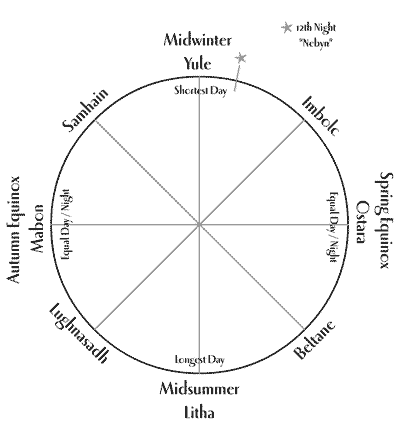Unlike the roman calandar, to the Celts time is circular rather than linear. The Celtic year began at Samhain passes through the other four festivals and albans, and back to Samhain, thus starting all over again. The Wheel of the year is the celtic timing of the seasons and rituals, it's calculated by the seasons and the sun's position relative to Earth, that controls the climate and soil productivity, affecting the temperature and food crops. There are four main festivals Samhain, Imbolc, Beltane and Lughnasadh, and the Albans among them, which are the equinoxes and solstices.

Samonios (Samhain) - 31st October (pronounced Sow-in): The Wheel of the Year is seen to begin at Samhain, which is also known as Hallowe'en or All Hallows Eve. This is the Celtic New Year, when the veil between the worlds of life and death stands open. Samhain is a festival of the dead, when Pagans remember those who have gone before and acknowledge the mystery of death. As Pagans we celebrate death as a part of life.
Medio Giamon (Mean Geimhridh / Winter Solstice) - 21st December (Yule in wicca, archaic form Geola, pronounced Yula): Marks the beginning of winter. It usually occurs around day 22 December in the northern hemisphere and 21 June in the southern hemisphere, it's related with the conception of birth and rebirth. Today this date is revived in the celebration of the Neopagan Sabbat Yule. Yule is the time of the winter solstice, when the sun child is reborn, an image of the return of all new life born through the love of the Gods. The Norse had a God Ullr, and within the Northern Tradition Yule is regarded as the New Year.
Ambivolcaia (Imbolc) - 2nd February: The festival that marks the beginning of spring. Most commonly it is celebrated on 1 or 2 February (or 12 February, according to the Old Calendar) in the northern hemisphere and 1 August in the southern hemisphere. These dates fall approximately halfway between the Winter Solstice and the Spring Equinox.
Medio Vasantos (Mean Earraigh / Spring Equinox) - 21st March (Ostara in wicca, archaic form Eostr): Night and day stand equal. The Sun grows in power and the land begins to bloom. By Spring Equinox, the powers of the gathering year are equal to the darkness of winter and death. For many Pagans, the youthful God with his hunting call leads the way in dance and celebration. Others dedicate this time to Eostre the Anglo- Saxon Goddess of fertility.
Belotenia (Beltane) - 30th April: The powers of light and new life now dance and move through all creation. The Wheel continues to turn. Spring gives way to Summer's first full bloom and Pagans celebrate Beltane with maypole dances, symbolizing the mystery of the Sacred Marriage of Goddess and God.
Medio Samon (Mean Samraidh / Midsummer) - 21st June (Litha in wicca): At summer solstice is the festival of Midsummer. Called Litha in wicca, the God in his light aspect is at the height of his power and is crowned Lord of Light. It is a time of plenty and celebration.
Medio Antumnon (Mean Foghamar / Autumn Equinox) - 21 September (Mabon in wicca): Day and night stand hand in hand as equals. As the shadows lengthen, Pagans see the darker faces of the God and Goddess. For many Pagans, this rite honours old age and the approach of Winter.
Samonios again. (and thus continually)


The wheel of the year is the one held by Taranis, god of thunder and rain, it's featured on virtually all his images, he is shown holding the wheel in one hand and a thunderbolt in the other. For this reason The Wheel of the Year is also called The Wheel of Taranis.

Also known as Sun Cross, the wheel has eight or six spokes of the year that connects eight major divisions of the Celtic year. The longer days and shorter and the equinoxes are the four Albans. The other four (Samhain, Imbolc, Beltane and Lugnassadh) are called the Festival of Fire. Some older wheels has only beltane and samhain with the albans, so it only has six rays. The Albans are older, that's because some older wheels have only four or rays.
Pictures: http://www.gaias-garden.co.uk/
http://bellovesos.multiply.com/
http://www.naturalistsalmanac.com/
No comments:
Post a Comment